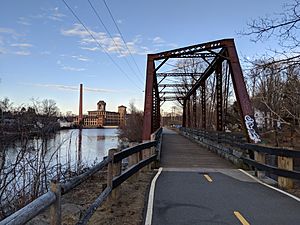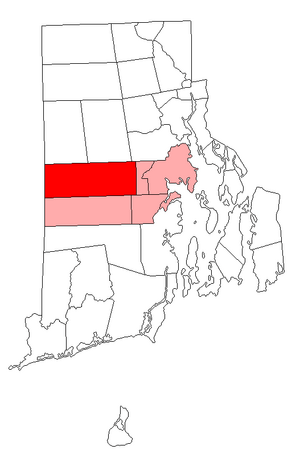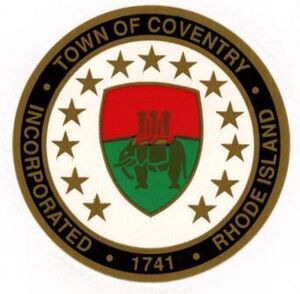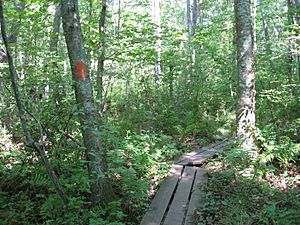Coventry, Rhode Island facts for kids
Quick facts for kids
Coventry, Rhode Island
|
|
|---|---|

|
|

Location in Kent County and the state of Rhode Island.
|
|
| Country | United States |
| State | Rhode Island |
| County | Kent |
| Area | |
| • Total | 62.3 sq mi (161.5 km2) |
| • Land | 59.5 sq mi (154.2 km2) |
| • Water | 2.8 sq mi (7.3 km2) |
| Elevation | 381 ft (116 m) |
| Population
(2020)
|
|
| • Total | 35,688 |
| • Density | 599/sq mi (231.4/km2) |
| Time zone | UTC−5 (EST) |
| • Summer (DST) | UTC−4 (EDT) |
| ZIP code |
02816
|
| Area code(s) | 401 |
| FIPS code | 44-18640 |
| GNIS feature ID | 1220082 |
Coventry is a town located in Kent County, Rhode Island, United States. It's known as a "New England town." In 2020, about 35,688 people lived here. Coventry is also part of the Pawtuxet River Valley area.
Contents
Exploring Coventry: Geography and Climate
Where is Coventry?
Coventry is a large town in Rhode Island. It covers about 62.3 square miles (161.5 square kilometers). Most of this area, 59.5 square miles (154.2 square kilometers), is land. The rest, 2.8 square miles (7.3 square kilometers), is water.
The town shares its borders with several other towns. To the east, you'll find West Warwick. To the north are Foster, Scituate, and Cranston. South of Coventry are West Greenwich and East Greenwich. Finally, to the west, it borders Sterling, Connecticut.
Did you know Coventry is the biggest town in Rhode Island by land area? Only South Kingstown, Rhode Island is larger when you count both land and water.
What's the Weather Like?
Coventry has an oceanic climate. This means it usually has mild temperatures and rain throughout the year. It doesn't get too hot or too cold.
| Climate data for Coventry, Rhode Island, 1991-2020 normals | |||||||||||||
|---|---|---|---|---|---|---|---|---|---|---|---|---|---|
| Month | Jan | Feb | Mar | Apr | May | Jun | Jul | Aug | Sep | Oct | Nov | Dec | Year |
| Mean daily maximum °F (°C) | 36.4 (2.4) |
38.5 (3.6) |
47.0 (8.3) |
60.5 (15.8) |
71.0 (21.7) |
79.6 (26.4) |
85.0 (29.4) |
82.0 (27.8) |
74.3 (23.5) |
62.3 (16.8) |
51.5 (10.8) |
41.8 (5.4) |
60.8 (16.0) |
| Daily mean °F (°C) | 27.4 (−2.6) |
29.4 (−1.4) |
36.3 (2.4) |
48.4 (9.1) |
59.2 (15.1) |
68.3 (20.2) |
74.3 (23.5) |
72.0 (22.2) |
64.1 (17.8) |
52.3 (11.3) |
41.8 (5.4) |
33.1 (0.6) |
50.5 (10.3) |
| Mean daily minimum °F (°C) | 18.4 (−7.6) |
20.3 (−6.5) |
25.6 (−3.6) |
36.3 (2.4) |
47.4 (8.6) |
56.9 (13.8) |
63.6 (17.6) |
61.9 (16.6) |
53.9 (12.2) |
42.2 (5.7) |
32.1 (0.1) |
24.3 (−4.3) |
40.2 (4.6) |
| Average precipitation inches (mm) | 4.47 (114) |
3.45 (88) |
5.03 (128) |
4.72 (120) |
3.62 (92) |
4.11 (104) |
3.21 (82) |
4.33 (110) |
3.86 (98) |
5.27 (134) |
4.40 (112) |
5.49 (139) |
51.96 (1,321) |
| Source: NOAA | |||||||||||||
Coventry's Past: A Look at its History
Early Days and Founding
English colonists first settled in the area that is now Coventry in the early 1700s. Back then, it was part of a larger town called Warwick. Because it was quite far from Warwick's main center, this area grew slowly at first.
By 1741, about 100 families lived there. They asked the Rhode Island government to create their own town. Their request was approved, and the new town was named "Coventry." It was named after a city in England.
For the rest of the 1700s, Coventry was mostly a farming town. Some old buildings from this time still exist today. These include the Waterman Tavern (built in the 1740s) and the Nathanael Greene Homestead (from the 1770s). The oldest church, Maple Root Baptist Church, started its congregation in 1762.
Coventry During the Revolutionary War
During the Revolutionary War, the people of Coventry strongly supported the American fight for independence. A famous resident, Nathanael Greene, became a very important general in the American army. By the end of the war, he was the second-in-command, right after George Washington himself!
The Industrial Revolution Arrives
In the 1800s, big changes came to Coventry with the Industrial Revolution. The first factory was built in the village of Anthony. Over the next 100 years, the eastern part of town became very industrial. Many factories were built in villages like Anthony, Washington, Quidnick, and Harris.
Many of these old factories are still standing. The village centers, especially Anthony and Quidnick, still look much like they did back then. The town's population also changed. People from French Canadian and Irish backgrounds moved to Coventry for jobs in these new factories. By the late 1800s, almost a quarter of the people in Coventry were born outside the U.S. For many in eastern Coventry, French was their main language.
Changes in the 20th Century

The 1900s brought more changes. Cars became popular, which meant people used trains less. The old railroad tracks were removed in the 1970s. Later, in the early 2000s, these old tracks were turned into a walking and biking path called the Washington Secondary Rail Trail.
By the middle of the 1900s, most of the factories in Coventry had closed. Industry largely left the town.
Since the late 1900s, more people have moved to Coventry. The eastern part of town has become more like a suburb. In recent years, there's been a movement to limit new building in the western part of town. This helps keep its rural, natural feel.
Fun Things to Do in Coventry: Recreation
Coventry has many places for fun and outdoor activities.
Sports and Water Fun
The town has youth sports leagues for football, basketball, baseball, and softball. In fact, a Coventry youth football team won a national title in 2006!
If you like fishing, Route 14 has Carbuncle Pond. This 39-acre (15.8-hectare) pond is a great spot for freshwater fishing. Johnson's Pond is another popular place for fishing and water sports. Wakeboarding Magazine even called Johnson's Pond the best place for wakeboarding in Rhode Island!
Hiking and Biking Trails
The George B. Parker woodland is a large area of 860 acres (3.5 square kilometers). It's owned by the Audubon Society of Rhode Island and has many hiking trails to explore.
Coventry has also been working on the Coventry Greenway. This is a path for walking and biking built on an old railroad line. It's part of the East Coast Greenway, a huge trail that goes all the way from Maine to Florida. The Coventry Greenway stretches for about 15 miles (24 km) from the Connecticut state line to the West Warwick town line. It's a great place for walking, cycling, and even horseback riding.
Coventry's Villages
Coventry is made up of many smaller communities called villages. Most of these were founded in the 1800s. Here are some of them:
- Anthony – A factory village in the eastern part of town.
- Arkwright – Another factory village.
- Blackrock – Named after a large dark rock.
- Colvintown – Named after the first families who settled there.
- Coventry Centre – This village is right in the middle of Coventry.
- Fairbanks – A factory village along the Moosup River.
- Greene – An old railroad village in the western part of town.
- Harris – A factory village in the northeastern part of town.
- Hopkins Hollow – A quiet, rural area in the southwestern part of town that looks much like it did over 150 years ago.
- Quidnick – A factory village located near the border with West Warwick.
- Rice City – A rural village in the northwestern part of town. It has the old Rice Tavern (from 1804), which used to serve travelers.
- Spring Lake – A former factory village.
- Summit – A railroad village close to Greene.
- Tiogue – Once called Barclay.
- Washington – A factory village in the center of town.
- Whaley's Hollow – A factory village where the Waterman Tavern is located.
Historic Buildings and Places
Coventry is home to many old houses, churches, and cemeteries. You can find farmhouses from the 1700s scattered around town, and many are still lived in today. In the eastern part of town, there are many homes from the 1800s, from small houses for factory workers to large mansions.
The villages of Greene, Rice City, and Hopkins Hollow still look much like they did in the 1800s. Many of Coventry's churches also date back to the 1800s and are still active today.
Places on the National Register of Historic Places
Many important historical sites in Coventry are listed on the National Register of Historic Places. This means they are recognized for their historical value. Some of these include:
- Isaac Bowen House (built in 1795)
- Joseph Briggs House-Coventry Town Farm (built in 1790)
- Carbuncle Hill Archaeological District, RI-1072-1079
- General Nathanael Greene Homestead (built in 1770)
- Hopkins Hollow Village
- Interlaken Mill Bridge (built in 1885)
- Moosup River Site (RI-1153)
- Paine House (built in 1748)
- Pawtuxet Valley Dyeing Company (built in 1859)
- Read School (built in 1831)
- Rice City Historic District
- South Main Street Historic District (Coventry, Rhode Island)
- Waterman Tavern (built in 1744) – Historical Marker for Waterman Tavern – HMdb
- William Waterman House
- Wilson-Winslow House (built in 1812)
People of Coventry: Demographics
| Historical population | |||
|---|---|---|---|
| Census | Pop. | %± | |
| 1790 | 2,477 | — | |
| 1800 | 2,423 | −2.2% | |
| 1810 | 2,928 | 20.8% | |
| 1820 | 3,139 | 7.2% | |
| 1830 | 3,851 | 22.7% | |
| 1840 | 3,433 | −10.9% | |
| 1850 | 3,620 | 5.4% | |
| 1860 | 4,247 | 17.3% | |
| 1870 | 4,349 | 2.4% | |
| 1880 | 4,519 | 3.9% | |
| 1890 | 5,068 | 12.1% | |
| 1900 | 5,279 | 4.2% | |
| 1910 | 5,848 | 10.8% | |
| 1920 | 5,670 | −3.0% | |
| 1930 | 6,430 | 13.4% | |
| 1940 | 6,998 | 8.8% | |
| 1950 | 9,869 | 41.0% | |
| 1960 | 15,432 | 56.4% | |
| 1970 | 22,947 | 48.7% | |
| 1980 | 27,065 | 17.9% | |
| 1990 | 31,083 | 14.8% | |
| 2000 | 33,668 | 8.3% | |
| 2010 | 35,014 | 4.0% | |
| 2020 | 35,688 | 1.9% | |
| U.S. Decennial Census | |||
In 2000, there were 33,668 people living in Coventry. There were about 12,596 households. A household is a group of people living together. About 9,295 of these were families.
The population density was about 565.5 people per square mile (219.3 per square kilometer). This means how many people live in a certain area.
Most people in Coventry (about 97.60%) identified as White. Other groups included African American (0.39%), Native American (0.15%), and Asian (0.56%). About 1.14% of the population identified as Hispanic or Latino.
About 34.7% of households had children under 18 living with them. The average household had 2.63 people. The average family had 3.07 people.
The median age in town was 38 years old. This means half the people were younger than 38 and half were older. About 24.9% of the population was under 18.
Famous People from Coventry
Coventry has been home to several notable individuals:
- Henry B. Anthony (1815–1884) – He was a U.S. Senator and also served as the 21st governor of Rhode Island. He was born in Coventry.
- Henry P. Baldwin (1814–1892) – He was a U.S. Senator and the 15th governor of Michigan. He was also born in Coventry.
- Allen Bestwick (born 1961) – A well-known race announcer for NBC and ESPN/ABC, especially for his work with NASCAR.
- Peter Frechette – An actor.
- Nathanael Greene (1742–1786) – A very important general in the Continental Army during the Revolutionary War.
- Mike Stefanik – A driver in NASCAR.
Coventry's International Connections
Twin Towns
Coventry, Rhode Island, has a special connection with another city across the ocean. It is a "twin town" or "sister city" with:
 Coventry, United Kingdom
Coventry, United Kingdom
See also
 In Spanish: Coventry (Rhode Island) para niños
In Spanish: Coventry (Rhode Island) para niños



